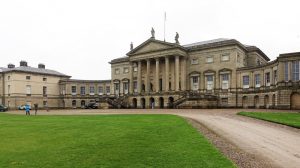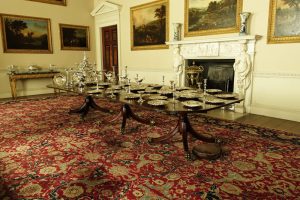After a delayed and drizzly start, the rain set in for the most of the day. Traffic hold ups added to the frustration of arriving, but when we did, the buzz of excitement and eagerness to explore went through the group. Mature trees in full leaf, set against parkland, surrounded the elegant and opulent façade of the 18th century house.
 Upon entering (through the servants’ entrance) we found ourselves in a corridor of hunting trophies and other animals with a notice warning that there was “taxidermy on display”. Thence to the lower entrance hall where we had a brief introduction to the House and the Curzon family. The servants’ rooms occupied the ground floor while the family used the first-floor rooms – which gave superb views over the grounds. We could go around the rooms clockwise and also see the library and the Museum of gifts and jewellery given to Lord George Curzon and to Lady Curzon while he was Viceroy of India. Some amazing carvings (albeit mostly in ivory) lined another of the corridors, showing a variety of doorways of temples in India.
Upon entering (through the servants’ entrance) we found ourselves in a corridor of hunting trophies and other animals with a notice warning that there was “taxidermy on display”. Thence to the lower entrance hall where we had a brief introduction to the House and the Curzon family. The servants’ rooms occupied the ground floor while the family used the first-floor rooms – which gave superb views over the grounds. We could go around the rooms clockwise and also see the library and the Museum of gifts and jewellery given to Lord George Curzon and to Lady Curzon while he was Viceroy of India. Some amazing carvings (albeit mostly in ivory) lined another of the corridors, showing a variety of doorways of temples in India.
The whole house was a showpiece designed by Robert Adam to impress guests – and us! The grand marble Hall with fluted pillars of alabaster certainly made a statement. Then we found out from the very knowledgeable and friendly room guide that the pillars had originally been made of three blocks but the owner didn’t like to see the joins, so had a large number of workmen flute the columns in situ. Much money has been spent by the National Trust in recent years to renovate the marble floor which was decorated to resemble a fountain – in the Italian style. Italianate carved plaster ceilings and decorations were to be found in most rooms – and this was echoed in the lampshades in the restaurant which were patterned to resemble delicate plaster carvings, when seen from underneath.
 The splendour of the rooms was shown in the turquoise damask bedroom and other lined walls. A picture of Lady Curzon, daughter of a Chicago millionaire, showed her wearing the “famous” peacock dress and that of Lord Curzon showed him in coronation robes after attending the Coronation Durbar in Delhi in 1901. Both Lord and Lady Curzon are buried in the church next to the house.
The splendour of the rooms was shown in the turquoise damask bedroom and other lined walls. A picture of Lady Curzon, daughter of a Chicago millionaire, showed her wearing the “famous” peacock dress and that of Lord Curzon showed him in coronation robes after attending the Coronation Durbar in Delhi in 1901. Both Lord and Lady Curzon are buried in the church next to the house.
As well as being an MP, Secretary of State to India and then Viceroy, (when he saved the Taj Mahal from destruction) Foreign Secretary and Chancellor of Oxford University, Lord Curzon collected art and bought Tattershall Castle and Bodiam Castle, both of which he repaired and gave to the Nation.
Outside, the arched stables were not to be missed. They provided stabling for 48 (named) horses with 21 stable boys to care for them – living above the stables. The coach house was opened sided but provided some shelter. The gardens, though wet, were colourful with wisteria, azaleas and rhododendrons next to the parkland with many mature trees. The church was certainly worth a visit with some impressive Victorian stained glass, and there was a second- hand bookshop in one of the stable yard buildings, where several of us found something of interest. The café was where we enjoyed lunch or several cups of tea – and the “scone of the month”, which was rhubarb and rosemary.
The ivory items were a sign of their times as were the sheer number of “gifts” in the Museum which to us, now, may seem evidence of a former age of Imperialism. The land had been in the same family since the Norman Conquest, and earlier houses on the site had now been replaced by this impressive live-in monument to the Curzon family.
The whole day was enjoyable despite the weather, and comments ranged from the beautiful green surroundings, the helpful and knowledgeable room stewards, to the sheer “OTT” opulence of a memorable building, “built to impress”.
